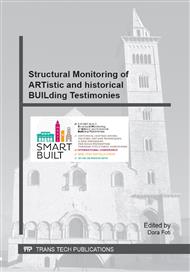p.193
p.198
p.204
p.212
p.218
p.225
p.231
p.237
p.243
Synchronization Issues in an Innovative Wireless Sensor Network Architecture Monitoring Ambient Vibrations in Historical Buildings
Abstract:
The problem of bridging the gap between the traditional wired monitoring systems and the wireless ones, was the objective of an innovative network architecture that elegantly combined benefits from both approaches. The monitoring focus is on historical buildings in which installing wires maybe range from difficult (e.g., fragile constructions) to impossible (e.g., prohibitive legislation). However, this innovative approach is vulnerable with respect to synchronization issues. In particular, all data sensed by different sensors need to have the correct universal time stamp. Since under this approach there is no central entity to take a synchronization role, in this paper the use of a local NTP server is proposed and as it is shown here using experimental results, this approach suffices for the particular monitoring needs. Thus, the claim that the innovative system can efficiently support the required monitoring of ambient vibrations in historical buildings.
Info:
Periodical:
Pages:
225-230
Citation:
Online since:
August 2014
Price:
Сopyright:
© 2015 Trans Tech Publications Ltd. All Rights Reserved
Share:
Citation:



